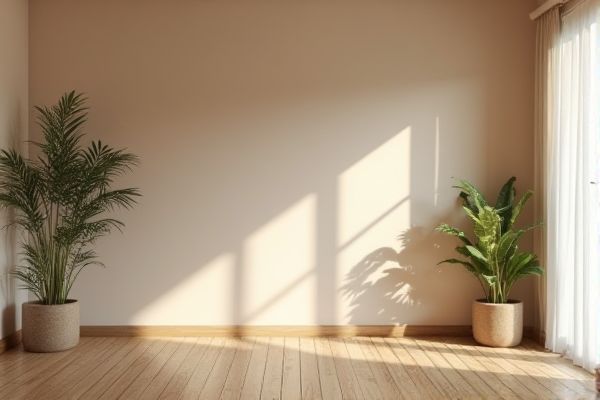
Choosing between an accent wall and full paint depends on the impact you want in your space and your personal style preferences, with accent walls offering a focal point and full paint providing a uniform look. Explore the rest of the article to discover which option best suits Your home transformation goals.
Table of Comparison
| Feature | Accent Wall | Full Paint |
|---|---|---|
| Definition | Painting one wall in a contrasting color to create a focal point. | Painting all walls in a room uniformly for a cohesive look. |
| Cost | Lower cost due to painting only one wall. | Higher cost; requires more paint and labor. |
| Visual Impact | Creates a bold, eye-catching feature. | Provides a consistent, balanced ambiance. |
| Design Flexibility | Easy to update or change accent color. | More commitment; changing requires repainting entire room. |
| Room Size Effect | Can make rooms seem larger or highlight architecture. | Can make small rooms feel enclosed or large rooms unified. |
| Popular Use | Feature walls in living rooms, bedrooms, or offices. | Entire rooms including bedrooms, kitchens, and halls. |
Accent Wall vs Full Paint: Key Differences
An accent wall highlights a single wall with a bold color or pattern, creating a focal point that enhances room depth and personality. Full paint covers all walls uniformly, offering a cohesive and spacious feel with consistent color throughout the space. Accent walls provide dynamic visual interest, while full paint ensures seamless design and easier coordination with decor.
Benefits of Accent Walls
Accent walls offer a visually striking focal point that adds depth and personality to any room without overwhelming the space. You can highlight architectural features or create a sense of dimension using bold colors or patterns, making your interior design more dynamic. This option is cost-effective and less time-consuming compared to full room painting, allowing for easy updates and customization.
Advantages of Painting All Walls
Painting all walls creates a cohesive and uniform look that enhances the sense of space and light in any room. It allows for greater design flexibility, making it easier to match furniture and decor without the distraction of contrasting colors. Your entire interior benefits from a clean, polished finish that can increase the home's value and appeal to a wider audience.
Design Impact: Bold Statements or Cohesive Feel
An accent wall creates a bold statement by highlighting one area with contrasting color or texture, drawing immediate attention and adding focal interest to the space. Full paint coverage offers a cohesive feel by unifying all surfaces under a single color palette, enhancing harmony and spaciousness. Choosing between an accent wall or full paint depends on the desired balance between visual drama and overall room integration.
Cost Comparison: Accent Wall vs Full Room Painting
Painting an accent wall typically costs 30-50% less than painting an entire room due to reduced paint usage and labor time. Accent walls require fewer materials, averaging $150-$300 depending on size, while full room painting ranges from $300-$800 or more. This cost difference makes accent walls a budget-friendly option for adding style without the expense of a full paint job.
Color Selection Strategies
Choosing the right color for an accent wall involves selecting a bold or contrasting shade that highlights architectural features or creates a focal point without overwhelming the space. Full paint color strategies emphasize harmony and flow, opting for subtle hues or monochromatic tones that unify the room and enhance its overall ambiance. You can balance both approaches by experimenting with complementary colors that either pop as an accent or gently blend to establish mood and depth.
Room Size and Lighting Considerations
Accent walls offer a strategic way to enhance room size perception by creating focal points that draw the eye, making small spaces feel more dynamic without overwhelming them. Full paint coverage can visually expand a room when using lighter colors, reflecting more light and amplifying natural brightness, especially in rooms with limited windows. In dimly lit or compact rooms, balancing accent walls with full paint helps optimize light distribution and spatial harmony for a comfortable atmosphere.
Best Rooms for Accent Walls
Accent walls work best in living rooms, bedrooms, and dining areas where a single bold color or textured finish can create dramatic focal points that enhance the room's personality. Full paint coverage suits spaces like kitchens and bathrooms, where consistent color promotes cleanliness and simplicity. Your choice depends on the room's function and desired visual impact, with accent walls offering a stylish highlight without overwhelming the space.
Maintenance and Longevity
Accent walls generally require less maintenance than full paint jobs, as only one wall is subject to wear and tear, reducing the need for frequent touch-ups. Full paint coverage can offer better long-term protection to all wall surfaces, helping to prevent discoloration and damage over time. The durability of either option depends significantly on paint quality and surface preparation, with high-quality, washable paints extending longevity and simplifying maintenance.
Which Option Is Best for Your Space?
Choosing between an accent wall and full paint depends on your room's size, lighting, and design goals. An accent wall creates a focal point by highlighting one section with a bold color, ideal for smaller spaces or adding character without overwhelming. Full paint offers a cohesive, uniform look that can make your space feel larger and more open, perfect for rooms needing a seamless backdrop.
 homyna.com
homyna.com